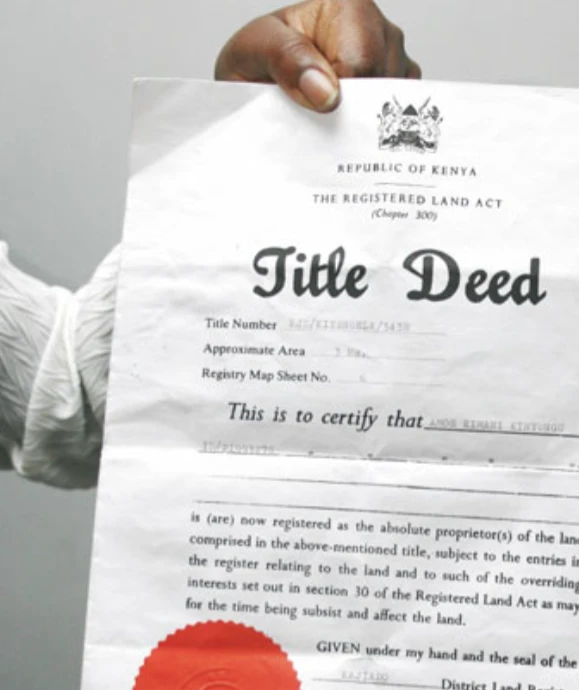How to Confirm That The Title Company is Legit: Legitimate
When discussing real estate investment, the topic of title deeds often arises. This document is crucial as it serves as proof of ownership of land or a house.
In Kenya, title deeds play a significant role, with potential buyers typically conducting a title deed search to verify the actual owner before making an offer.
Despite the widespread acknowledgment of the importance of owning a title deed, many people lack sufficient knowledge about this critical document.

Questions such as the types of title deeds available, the main components of a title deed, how to distinguish between a genuine and a fake title deed, the process of transferring title deeds from one name to another, how to obtain a replacement title deed if lost, and whether foreigners can own land in Kenya often arise.
To address these questions, we have conducted thorough research on title deeds and compiled the information into this comprehensive guide.
Here is everything you need to know about title deeds:
A title deed is a legal document that serves as proof of ownership of property, whether it be land or a housing unit.
Step-by-Step Guide on How to Conduct Title Deed Search
To verify the authenticity of a title deed in Kenya, follow these steps:
- Create an account on the e-Citizen platform.
- Visit the Ministry of Land and Physical Planning section.
- Choose the land search option.
- Insert the title number of the property you want to search.
- Complete the online land search form and submit it.
- Make a payment of Ksh 550 either through Mpesa or by card.
- Print the results of the search.
The results of the title deed search will help you determine whether the title deed is genuine or fake.
This is how to differentiate a fake and a genuine title deed
Truth be told, you cannot differentiate between a fake and an original title deed just by looking at it.
However, based on the description provided above, you can identify a document as not being a title deed if it does not have the specified pages.
The most effective way to distinguish between a genuine title deed and a fake one is by conducting a title deed search at the Land Registry. This search can be done either manually or online.
If impressive follow for more on our blog page as sampled below:
- Flamingo Company Exposed: Legitimacy and Transparency Examined
- Is Aura a Legit Company? SEO Investigation Report
- Is Aura a Legit Company? SEO Investigation Report
- Legitimacy Check: Are Credit Repair Companies Worth Your Trust?
How to check Title Deed online
You can now check your title deed details online thanks to the Ardhisasa Platform and the e-Citizen platform.
Simply sign up for these platforms, submit your title deed details, and await the results. This is also the best way to verify the validity of your title.
Step-by-step guide on how to change a name from one to another in a title deed
Changing the name on a title deed from one to another is a common process, especially in the buying and selling of land and housing units.
The average duration for this change is 90 days or less, according to the Ministry of Lands. However, this duration can vary depending on the circumstances at a specific Land Registry.
To conduct this activity effectively, you will need to obtain several documents.
These include a report from a property valuer for the land or house, approval to transfer the property, a Stamp Duty Bill form, ID and KRA PIN certificates for both parties, colored passport-size photos for each party, and the title deed to be transferred.
How to put and remove a caveat on a title deed
So far, we have explored various aspects of title deeds. Now, let’s delve into something known as a caveat in title deeds.
Are you familiar with this term? This section aims to provide more insight into title deed caveats.
We will address the following questions:
- What is a caveat?
- How do you place a caveat on a title deed?
- How is a caveat on a title deed removed?
- What happens when someone places a wrong caveat?
What is a Caveat?
A caveat is a notice placed on a specific title deed to prevent actions such as selling, buying, or using it as collateral for a loan.
In essence, a caveat is placed on a title deed to communicate to interested parties that someone’s interest takes priority.
If you suspect that someone may take advantage of your property, you can place a caveat on it.
How to place a Caveat
When placing a caveat in Kenya, there is a laid-down procedure and specific documents required. Here are the documents needed:
- The prescribed form (Form R.L. 22)
- An affidavit explaining the interest of the person placing the caveat on the land
- A copy of the title deed (or the title deed number)
- The fee for the process
The registrar then provides written notice to the affected property owner.
As long as the caveat remains registered, no action inconsistent with it shall be registered, except with the consent of the person who placed the caveat or by court order.